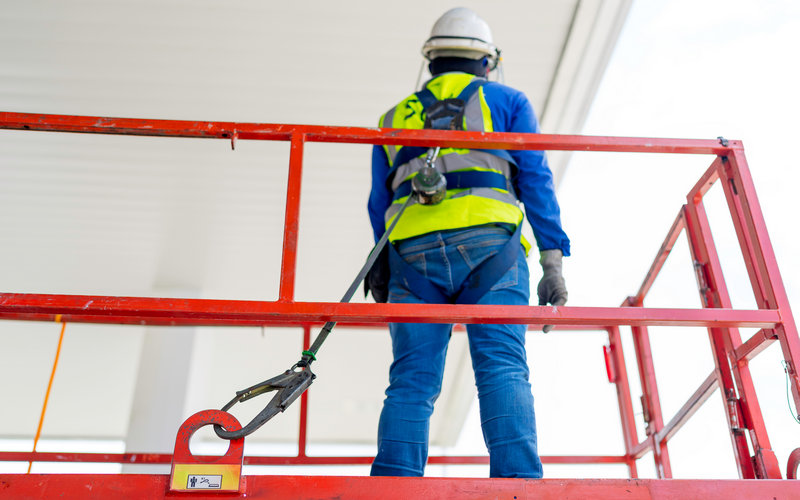Checklist for Safety Prior to Using A Scissor Lift
Working at heights can be quicker, safer, and more effective with the use of a scissor lift. They are the preferred option whether you’re painting a warehouse ceiling, setting up lighting for a function, or fixing a building’s exterior. However, such convenience comes with a price. A scissor lift rental can present significant safety hazards if not used carefully and with adequate planning.
That’s why it’s essential to follow a clear safety checklist before using a rented unit. Unlike equipment you own, a rental scissor lift may have been used by multiple operators, in different conditions, and with varying levels of maintenance. Before stepping onto the platform, make sure you’re aware of how it works, what its limits are, and whether the worksite is safe for operation. This guide walks you through everything you need to check before using a rented scissor lift — from initial inspection to team communication — to ensure your project runs smoothly and, most importantly, safely.
Verify The Rental Agreement and Machine Specs
Before starting anything, double-check your rental agreement and ensure the scissor lift you’re receiving matches your job requirements. Confirm the following:
Lift height and platform capacity: Ensure it reaches the height you need and can support the required weight.
Indoor vs. outdoor usage: Some scissor lifts are designed for indoor smooth surfaces, while others are rugged and made for uneven outdoor terrain.
Power type: Is it electric (battery-powered) or diesel? Each has different use cases.
This helps avoid delays, damage, or misuse due to a mismatch in specifications.
Inspect The Delivery Condition of The Lift
Once the rented lift arrives, conduct a thorough visual inspection before accepting delivery. Look for:
- Visible damage to the frame, platform, guardrails, or tires.
- Hydraulic leaks, loose hoses, or broken fittings.
- Tire wear and tear, especially if it’s for outdoor use.
- Control panel damage, including buttons, switches, or screens.
- Battery level and fluid levels, if electric.
Notify the rental company immediately if anything looks unsafe or faulty. Document issues with photos to protect yourself from responsibility.
Review The Operator’s Manual
Even if you’ve used a scissor lift before, each model may have differences. Take time to review the operator’s manual. Most rental companies provide a printed or digital version.
Key things to look for:
- Pre-operation checklist specific to the model.
- Weight and load limits for tools and personnel.
- Control functions (raise, lower, emergency stop).
- Stability and tipping guidelines.
- Wind tolerance limits (especially important for outdoor lifts).
Familiarizing yourself with this information reduces misuse and improves jobsite safety.
Inspect Safety Features and Devices
Scissor lifts come with built-in safety systems that must be checked before use. Key components include:
Emergency lowering system: Test it so that the platform can be lowered if power fails.
Guardrails and toe boards: Must be secure and intact to prevent falls.
Platform gates: Ensure they close and lock properly.
Tilt sensors: These prevent the lift from operating on uneven surfaces beyond safety thresholds.
Brakes and wheel locks: Especially important on sloped or raised surfaces.
Never operate the lift if any of these are missing or malfunctioning.
Check The Work Area
Before moving the lift into position, inspect the area for hazards:
- Overhead obstructions: Power lines, beams, or low ceilings.
- Uneven surfaces or drop-offs.
- Slopes or soft ground that could affect balance.
- Nearby pedestrian or vehicle traffic.
- Wind conditions for outdoor lifts (follow the manufacturer’s rated wind speed limit).
Clear the area of any loose tools, debris, or materials that could interfere with safe operation.
Wear The Right Personal Protective Equipment (PPE)
Operators and anyone on the platform should wear proper PPE. Depending on the job and height, this may include:
- Hard hat.
- Safety harness with a lanyard (required if the manufacturer specifies it).
- Hi-visibility vest.
- Protective footwear.
- Safety glasses.
While scissor lifts are enclosed by guardrails, PPE provides an added layer of protection in case of mechanical failure or collisions.
Test The Controls and Emergency Stop
Conduct a function test before elevating the platform:
- Turn on the machine and operate the raise and lower controls.
- Test the emergency stop button to ensure it cuts power instantly.
- Move the lift forward and backward if applicable.
- Activate the tilt alarm to confirm it works properly.
Doing this helps you detect any issues before workers are on the platform, preventing potential accidents.
Limit The Load and Occupancy
Overloading is a major cause of accidents. Know the platform capacity and stick to it:
- Add the combined weight of people, tools, and materials.
- Never exceed the rated capacity (listed on the machine).
- Limit the number of people on the platform to what’s recommended.
- Distribute weight evenly across the platform floor.
This prevents tipping, structural stress, and potential lift failure
Set Up Fall Prevention Measures
Even though scissor lifts are considered stable, you still need fall prevention protocols:
- Use a chain or a gate to close off the platform entrance.
- If required, wear a full-body harness and tie it to the designated anchor point.
- Don’t climb on guardrails or use ladders on the platform to reach higher.
Falls from scissor lifts can still cause serious injuries. Fall protection keeps your team compliant and safe.
Document and Communicate The Safety Plan
Before anyone uses the lift, make sure your team is briefed on the safety checklist:
- Conduct a toolbox talk or safety huddle.
- Assign a qualified lift operator—only trained workers should operate the lift.
- Post or share the safety checklist on-site.
- Create a protocol for reporting malfunctions or unsafe conditions.
Documentation not only improves safety but also helps with compliance if an inspection or incident occurs.
Final Thoughts
Safety isn’t just about ticking boxes — it’s about protecting lives and getting the job done right. Whether you’re a contractor, warehouse manager, or maintenance supervisor, following this scissor lift safety checklist is essential before using any rented lift.
By inspecting equipment, checking the worksite, understanding lift capabilities, and using proper PPE, you minimize risks and boost productivity. Safe use starts before the lift even moves.
If you’re ever unsure, talk to your rental provider. They’re usually happy to walk you through safety procedures or provide a brief training session.



